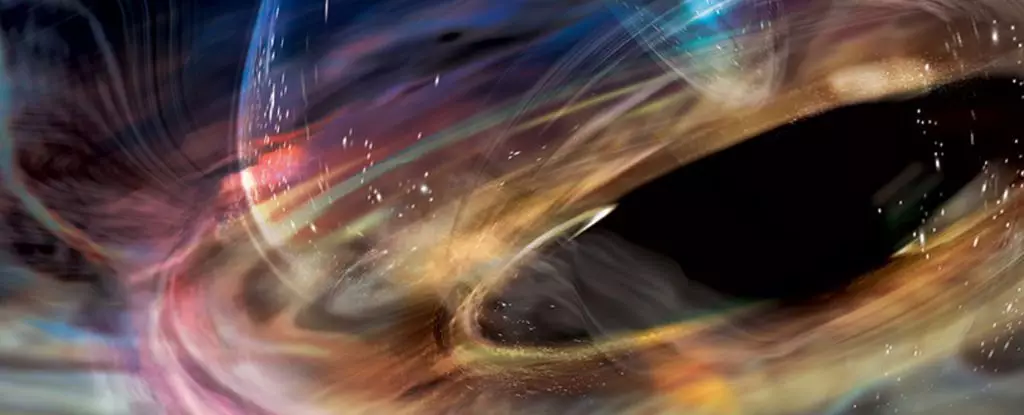Astrophysics never ceases to amaze us, often uncovering celestial phenomena that stretch the limits of our imagination. Among these phenomena lies an enigma that resides a staggering 275 million light-years away in the galaxy known as 1ES 1927+654. Here, a supermassive black hole is the central figure of an intricate cosmic dance that has puzzled astronomers for years. Recent observations have uncovered a curious companion—a white dwarf star dipping alarmingly close to the black hole’s event horizon, and with it, the potential for fresh insights into the workings of black holes themselves.
Black holes are intrinsically mysterious entities, shrouded in darkness that even light cannot escape. However, they exist within an ecosystem of interacting materials, often forming brilliant accretion disks composed of gas and dust. This swirling mass, heated to unimaginable temperatures, emits light that allows astronomers to discern behavior around these gravitational giants. In the case of 1ES 1927+654, the black hole is a relative lightweight, possessing about 1 million times the mass of our Sun. Simply put, it didn’t attract much attention until its activity indicated something unusual might be at play.
In 2018, the corona surrounding this black hole notably dimmed and then blossomed to life with an astonishing intensity. Such variability led scientists to theorize radical possibilities, including a phenomenon referred to as black hole polar reversal. Like a child peeking around the corner, researchers remained intrigued and observant about this newfound black hole’s antics.
Fast forward to June 2022, when the European Space Agency’s XMM-Newton space telescope began recording strange fluctuations in the X-ray emissions from 1ES 1927+654. The discoveries were gripping—variations in brightness appeared with a frequency not generally seen in black holes. These variations, known as quasi-periodic oscillations (QPOs), became tighter and more rapid, compressing from approximately 18 minutes down to under seven. Dr. Megan Masterson, a physicist from the Massachusetts Institute of Technology (MIT), aptly described this behavior as “absolutely nothing like a normal black hole.”
To decipher the meaning behind these rapid shifts in emissions, researchers turned their focus to the defining attributes of the X-ray flickers. Observations suggested they were commensurate with something orbiting perilously close to the event horizon, indicating a complex interplay of gravitational forces. The implications were both fascinating and terrifying—could an object be spiraling into doom while simultaneously illuminating the dark?
As experts sifted through potential candidates for the object causing these fluctuations, a white dwarf star emerged as a likely contender. White dwarfs are the remnants of low-mass stars that have exhausted their nuclear fuel, expelling their outer layers and leaving behind a hot, dense core. In the case of 1ES 1927+654, the calculations suggest that this white dwarf, measuring roughly 0.1 times the Sun’s mass, was on a delicate trajectory. As it drifted closer to the black hole, it found itself wedged in an orbit that would confine it to a space equivalent to four times the Sun’s radius, completing a cycle in a mere seven minutes.
What makes this scenario remarkable is the resilience of the white dwarf. Despite the chaos surrounding it, the star’s significant density offers a possible lifeline; it may survive lengthy encounters, its outer layers stripped away yet retaining enough momentum to potentially escape the black hole’s grip.
The implications of these observations extend beyond this particular system, providing a glimpse into the nature of extreme gravitational dynamics. As ongoing research continues to monitor this black hole and its elusive companion, astronomers are poised to uncover more about the limits of how celestial bodies interact in the harshest environments of our universe. Themes of gravitational capture, stability, and stellar evolution are all brought into focus, each discovery providing yet another piece of the cosmic puzzle.
The team studying 1ES 1927+654 embodies a spirit of relentless inquiry: “Never stop looking at it because it will probably teach us something new,” Dr. Masterson declares. As researchers remain vigilant, their observations will undoubtedly add to the vast tapestry of knowledge regarding black holes, white dwarfs, and the sprawling cosmic dance they engage in. With every flicker and flash, we inch closer to understanding not only the enigmatic behaviors of black holes but the very fabric of our universe.

